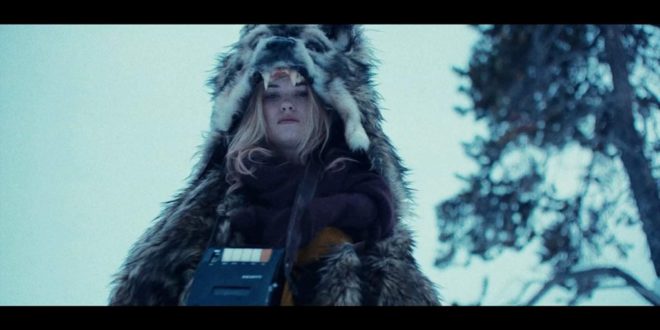Debut feature film director A. T. White’s Starfish is a feast for the eyes as well as the ears, a true breakout, genre defining film. Starfish is labelled as a cosmic horror, which in itself elevates my previous statement as the company this film is generally associated with are all huge hitting standouts in their own right. 2001: A Space Odyssey (1968), Event Horizon (1997), and The Mist (2007) all share this distinct nomenclature. So, come along with me as I try to open your eyes to this beautifully crafted mystic mystery of a picture which not only captured my heart, but also set my mind free.
Plot
When a mysterious signal from an unknown dimension summons the end of days, its appears as if only Aubrey is left on earth. Trapped in the apartment of her recently deceased best friend, the only clue she has is a single cassette left behind after her friends death, labeled: “THIS MIXTAPE WILL SAVE THE WORLD.”
Starfish begins with our main character, Aubrey Parker (Virginia Gardner: Halloween 2018 – read our review here), attending the funeral of her best friend, Grace (Christina Masterson: Truth or Dare 2017). Writer/Director/Composer A.T. White (Pulling Away 2013) sets the scene in a rural town where Aubrey breaks into the apartment of her deceased friend. There is something about a film set in a small town in the dead of winter that just resonates with me. The tone that it establishes is a wild swing from warm peacefulness to terrifyingly cold seclusion which is wielded at whim by the writer.
As the story progresses, we see that this quaint little town is not the peaceful quiet place it seemed the night before. The danger and story ramp up quickly, throwing Aubrey into a perilous situation, leaving her a prisoner in her friend’s home. A beast of some sort is trying to break into the restaurant directly beneath Aubrey’s domicile. Her walkie-talkie crackles to life, and she is saved by a mysterious voice that guides her on how to defeat it. After researching the message left on a cassette tape, Aubrey speaks once more to the voice on the walkie, and decides to go it alone.

The outside world though seemingly vacant proves to be littered with dangers as the narrative and look move to a living anime feel, then eventually a full on animated sequence. The ability and ease in which Starfish is able to transition to these different styles and paces is not lost on me, as I’ve witnessed countless other films with much higher budgets fall flat in their attempts. White clearly knows what he wanted the audience to experience, and masterfully composed every cut.
Films like Stanley Kubrick’s The Shining (1980 – read our retro review here), Rob Reiner’s Misery (1990), and Jim Makichuk’s mostly forgotten film, Ghostkeeper (1979), all utilize a setting that pulls the audience into a world that builds a complicated and intense story around just a few primary characters, and Starfish is one of those films. This works exceptionally well here as the gambit of emotions are portrayed eloquently by Gardner as she moves through the stages of grief. As we watch her, you can’t help but identify with their own personal experiences of loss.

The soundtrack of Starfish is as captivating and engulfing as its visual prowess. Be it a haunting instrumental to a full track song, there are few films that I have seen intertwine melody, song queues and story so effortlessly. While watching Starfish, I couldn’t help but research the music from this moving collaboration in order to listen to it on its own.
The way that White depicts the memories are done in a way that I have never previously seen. The visual representation of how Aubrey remembers them is done in a style that shook me. Anyone who has ever been driving down a highway and trailed off into their mind only to snap back to reality will understand what I mean about these visual representations of thought once they’ve seen this film.
Starfish is a python of film that starts off feeling familiar, gently welcoming you into its world. Once you’re comfortable, it slowly tightens its grasp, pulling you in ever so slightly, all the while soothing your soul with an intoxicating soundtrack. Just as you feel safe and serene, it constricts, changing your perception in a heartbeat. The ending of Starfish will leave you gasping for answers in the best possible way.

Final Thoughts
There are so many things I want to tell you about Starfish, but it is better if you experience them for yourself. I think that Yellow Veil Pictures and everyone involved in the making of this film deserve all the accolades they receive for this endeavor. This film was no small undertaking, and what shows up on the screen is a testament to that. After watching Starfish, I let the credits run through, and its message just kept ringing in my head. It was 8:30PM and I had to lay in bed to process what I had just watched.
It took me days to be able to properly write this review. That really says something about a film. I personally have no idea how J.J. Abrams and Bad Robot Productions didn’t scoop this up and add it to the Cloverfield legacy. It would have completely redeemed the disaster that was The Cloverfield Paradox (read our review here). It is in the same vein as the masterpiece that was 10 Cloverfield Lane (read our review here), with scenes that have a perfect tie in to the franchise. I think that it is was huge missed opportunity for Bad Robot Productions, but a perfect example of where the people at Yellow Veil Pictures is headed.
 PopHorror Let's Get Scared
PopHorror Let's Get Scared




